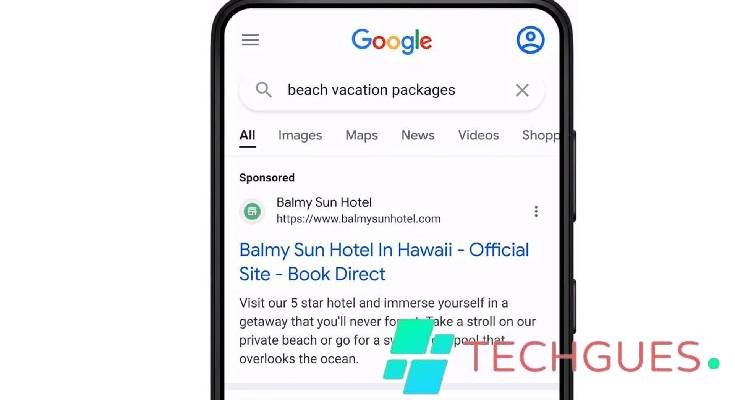In today’s digital age, where consumers are constantly bombarded with information, standing out from the crowd is paramount for businesses aiming to capture their audience’s attention. Google Sponsored Ads offer a powerful solution to this challenge, providing businesses with a direct pathway to reach their target audience amidst the vast landscape of online content.
Types of Google Sponsored Ads:
Google Sponsored Ads come in various formats, each tailored to specific marketing objectives and audience preferences:
Search Ads:
- Description and placement: Displayed at the top or bottom of search engine results pages (SERPs).
- Ad format: Text-based with extensions for additional information.
- Targeting options: Keywords, demographics, location, device type, etc.
Display Ads:
- Description and placement: Appearing across millions of websites and apps within the Google Display Network.
- Ad format: Rich media including images, videos, and responsive designs.
- Targeting options: Contextual targeting, audience targeting, remarketing, etc.
Video Ads (YouTube Ads):
- Description and placement: Shown before, during, or after YouTube videos.
- Ad format: Skippable, non-skippable, or bumper ads.
- Targeting options: Demographics, interests, placements, etc.
Shopping Ads:
- Description and placement: Displayed alongside search results for product-related queries.
- Ad format: Product listing ads (PLAs) showcasing product images, prices, and store information.
- Targeting options: Product attributes, audience segments, remarketing lists, etc.
App Ads:
- Description and placement: Promoted within Google Play Store search results, YouTube, Google Display Network, etc.
- Ad format: App install ads or app engagement ads.
- Targeting options: Device type, operating system, user interests, etc.
Benefits of Google Sponsored Ads:
Google Sponsored Ads offer numerous benefits for businesses looking to expand their online presence and drive tangible results:
Increased visibility and reach:
Sponsored ads ensure that businesses appear prominently in relevant search results, increasing brand exposure and driving traffic to their websites. Targeted advertising: With sophisticated targeting options, businesses can reach their ideal audience segments based on demographics, interests, and online behaviors. Cost-effective advertising solution: Google’s pay-per-click (PPC) model ensures that businesses only pay when users engage with their ads, making it a cost-effective option for businesses of all sizes. Measurable results and performance tracking: Google Ads provides comprehensive analytics and reporting tools, allowing businesses to track the performance of their campaigns in real-time and make data-driven optimizations for better results.
Setting Up Google Sponsored Ads:
Creating and launching Google Sponsored Ads involves several key steps: Creating a Google Ads account: Businesses can sign up for a Google Ads account and set up their billing information. Campaign setup: Define campaign goals, set budgets, and select bidding strategies based on campaign objectives. Ad creation: Develop compelling ad copy, visuals, and call-to-action (CTA) elements that resonate with the target audience. Targeting options: Utilize Google’s extensive targeting options to reach the right audience segments with precision. Monitoring and optimization: Regularly monitor campaign performance metrics such as click-through rate (CTR), conversion rate, and return on ad spend (ROAS), and make adjustments to optimize campaign performance over time.
Best Practices for Google Sponsored Ads:
To maximize the effectiveness of Google Sponsored Ads, businesses should follow these best practices: Conduct keyword research: Identify relevant keywords that align with your business objectives and target audience’s search intent. Create compelling ad copy and visuals: Craft attention-grabbing headlines, concise ad copy, and visually appealing creatives that entice users to click on your ads. Optimize landing pages for conversions: Ensure that landing pages are user-friendly, mobile-responsive, and optimized for conversion actions such as form submissions or product purchases. Regularly monitor and adjust campaigns based on performance: Continuously analyze campaign metrics and make data-driven optimizations to improve ad relevance, targeting, and overall performance.
Case Studies or Examples:
Several businesses have leveraged Google Sponsored Ads to achieve remarkable results: Case Study 1: Company A increased website traffic by 50% and generated a 30% increase in online sales by implementing targeted Search and Display Ads campaigns. Case Study 2: Company B achieved a 3x return on ad spend (ROAS) by optimizing its Shopping Ads campaigns and leveraging dynamic remarketing strategies. Case Study 3: Company C boosted app installs by 80% and improved user engagement by 50% through strategic App Ads placements and continuous performance optimizations.
Conclusion:
In conclusion, Google Sponsored Ads offer businesses a powerful platform to enhance their online visibility, reach their target audience, and drive measurable results. By leveraging various ad formats, sophisticated targeting options, and data-driven optimization strategies, businesses can create impactful campaigns that resonate with their audience and achieve their marketing objectives. As digital marketing continues to evolve, Google Sponsored Ads remain a cornerstone of effective online advertising strategies, empowering businesses to thrive in today’s competitive landscape.




